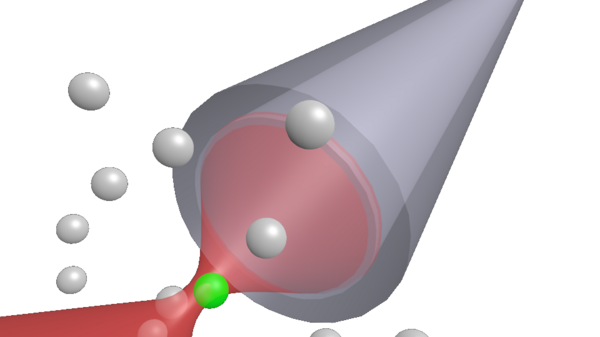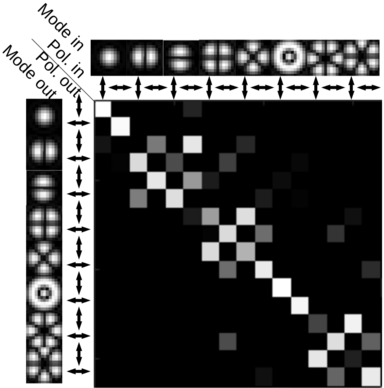
Esben Ravn Andresen
Axes de recherche

The "lensless endoscope" represents the ultimate limit in miniaturization of imaging tools: an image can be transmitted through a (multi-mode or multi-core) fiber by numerical or physical inversion of the fiber's pre-measured transmission matrix. However, the transmission matrix changes completely with only minute conformational changes of the fiber, which has so far limited lensless endoscopes to fibers that must be kept static which limits its practical applications. In our work, we show how the properties of specialty multi-core fibers can help to overcome this challenge.
Cellular-level microscopic imaging has long been a vital tool in biomedical research. Recent years have seen numerous efforts to miniaturize imaging instruments with the aim of opening the door to cellular-level imaging in behaving animals.
A recent example is the miniaturized head mounted microscope for fluorescence imaging on freely behaving animals reported in Ref.~[1] (weight 2 g) . This approach has light source, filters, imaging optics, and CMOS camera integrated into a head mounted device.
A different approach bases the light delivery and collection on optical fiber which brings the advantage that light source and detectors can be remote rather than integrated in the head mounted device which then only houses miniaturized actuators and/or imaging optics. As a consequence and added benefit, optical fiber-based miniaturized microscopes/endoscopes are able to use pulsed laser sources and perform non-linear imaging---to date the only demonstrations have been with optical fiber-based systems, see for example the demonstrations of two-photon fluorescence imaging in Ref. [2] (3 mm x 40 mm) which employs a piezo-electric actuator ; and Ref. [3] (2.15 g, 1cm^3) which employs a MEMS mirror to perform point-scanning imaging . For an overview of the most "conventional" optical fiber-based approaches, see Ref. [4].
A new approach to fiber-based endoscopes came about in 2011 [5-10] when spatial-light modulator technology made it possible to measure and invert the transmission matrix (TM) of a multi-mode fiber (MMF) or multi-core fiber (MCF). This approach does away with the need to have imaging optics between fiber and sample and consequently, this approach is often termed "Lensless endoscopes" and represents the ultimate limit in miniaturization, since the head-mounted device can be as small as an optical fiber itself (diameter typically less than few hundred micrometers).
Cellular-level imaging in live mice by lensless endoscopes has recently been demonstrated for the first time in Refs. [11,12].
In our earlier work we have shown how lensless endoscopes based on MCF simplify many of the considerations pertaining to the TM [13]. In particular, in Ref. [14], we showed that the extrinsic contribution to the TM of a MCF is simply a diagonal matrix with complex elements of unit norm and argument which is linear in the transverse coordinate, i.e. a matrix with only two free parameters.
In both the MMF or MCF case, however, the great challenge remains that following each conformational change of the fiber either the additional extrinsic contribution or the new TM must be experimentally quantified whether directly or indirectly in order for aberation-free imaging to continue. This is the main obstacle standing between us and a flexible lensless endoscope which would open the possibility for minimally-invasive imaging in behaving animals, and one of the principal drivers of our current work.
[1] Y. Ziv and K. K. Ghosh, “Miniature microscopes for large-scale imaging of neuronal activity in freely behaving rodents,” Curr. Opin. Neurobiol. 32, 141–147 (2015).
[2] D. R. Rivera, C. M. Brown, D. G. Ouzounov, I. Pavlova, D. Kobat, W. W. Webb, and C. Xu, “Compact and flexible raster scanning multiphoton endoscope capable of imaging unstained tissue,” Proc. Natl. Acad. Sci. United States Am. 108, 17598–17603 (2011).
[3] W. Zong, R. Wu, M. Li, Y. Hu, Y. Li, J. Li, H. Rong, H. Wu, Y. Xu, Y. Lu, H. Jia, M. Fan, Z. Zhou, Y. Zhang, A. Zang, L. Chen, and H. Cheng, “Fast high-resolution miniature two-photon microscopy for brain imaging in freely behaving mice,” Nat. Meth. 14, 713–722 (2017).
[4] B. A. Flusberg, E. D. Cocker, W. Piyawattanametha, J. C. Jung, E. Cheung, L. M., and M. Schnitzer, “Fiber-optic fluorescence imaging,” Nat. Methods 2, 941–950 (2005).
[5] A. J. Thompson, C. Paterson, M. A. A. Neil, C. Dunsby, and P. M. W. French, “Adaptive phase compensation for ultracompact laser scanning endomicroscopy,” Opt. Lett. 36, 1707–1709 (2011).
[6] T. Cizmar and K. Dholakia, “Shaping the light transmission through a multimode optical fibre: complex transformation analysis and applications in biophotonics,” Opt. Express 19, 18871–18884 (2011).
[7] I. N. Papadopoulos, S. Farahi, C. Moser, and D. Psaltis, “Focusing and scanning light through a multimode optical fiber using digital phase conjugation,” Opt. Express 20, 10583–10590 (2012).
[8] Y. Choi, C. Yoon, M. Kim, T. D. Yang, C. Fang-Yen, R. R. Dasari, K. J. Lee, and W. Choi, “Scanner-free and wide-field endoscopic imaging by using a single multimode optical fiber,” Phys. Rev. Lett. 109, 203901 (2012).
[9] E. R. Andresen, G. Bouwmans, S. Monneret, and H. Rigneault, “Toward endoscopes with no distal optics: video-rate scanning microscopy through a fiber bundle,” Opt. Lett. 38, 609–611 (2013).
[10] E. R. Andresen, G. Bouwmans, S. Monneret, and H. Rigneault, “Two-photon lensless endoscope,” Opt. Express 21, 20713–20721 (2013).
[11] S. Ohayon, A. M. Caravaca-Aguirre, R. Piestun, and J. J. DiCarlo, “Minimally invasive multimode optical fiber microendoscope for deep brain fluorescence imaging,” Biomed. Opt. Express 9, 1492–1509 (2018).
[12] S. Vasquez-Lopez, R. Turcotte, V. Koren, M. Plöschner, Z. Padamsey, M. J. Booth, T. Cizmar, and N. Emptage, “Sub-cellular spatial resolution achieved for deep-brain imaging in vivo using a minimally invasive multimode fiber,” Light. Sci. & Appl. 7, 110 (2018).
[13] E. R. Andresen, S. Sivankutty, V. Tsvirkun, G. Bouwmans, and H. Rigneault, “Ultra-thin endoscopes based on multi-core fibers and adaptive optics: a status review and perspectives,” J. Biomed. Opt. 21, 121506 (2016).
[14] V. Tsvirkun, S. Sivankutty, G. Bouwmans, O. Vanvincq, E. R. Andresen, and H. Rigneault, “Bending-induced inter-core group delays in multicore fibers,” Opt. Express 25, 31863–31875 (2017).

In these years, we observe a continuous increase in demand for high bit rate communications concomitant with the saturation of the existing single-mode fiber (SMF) networks. Consequently, the time is ripe for the study of new fiber types with the potential for increased transmission capacity through modal division multiplexing (MDM) of data. One such class of fibers is the few-mode fiber (FMF) which can guide light in N (typically around 10) independent modes, each able to act as a channel that carries a sequence of data, thus augmenting the transmission capacity by the factor N compared to standard SMF. Ultimately, networks of FMF could replace current SMF networks once demand for transmission capacity starts to outstrip supply [1].
The average behavior of a FMF can be described by its cross-talk matrix (XTM), a real matrix describing its mode-dependent loss (MDL) and the power exchange (cross-talk) between modes. The FMF's instantaneous behavior must be described by its transmission matrix (TM), a complex linear transformation that links the amplitude and phase of every input mode to every output mode. In such fibers, advanced digital signal processing (DSP) has to be applied to the outcoming data streams in order to correctly recover the data: we speak about multiple-input multiple-output (MIMO) -DSP. MIMO is a set of algorithms that must calculate and track the instantaneous state of the multimodal channel, i.e. the
instantaneous TM from the received signal alone and then apply the inverse TM to the received signal in order to undo the information distortion taking place in the FMF. An exhaustive search for the TM is computationally very expensive, so a good description of the multi-modal channel represented by the FMF is desired in order to properly parametrize the MIMO algorithms so they can track the TM with sufficient speed.
The objectives of our research are to develop new ways to measure the multi-mode channel in the dynamical regime [2] and to ameliorate multi-mode channel models.
[1] D.J. Richardson et al., Nat. Photon., 7, 354–362 (2013).
[2] J. Yammine, A. Tandjè, M. Dossou, L. Bigot, E. R. Andresen, Appl. Phys. Lett. Photon. 4(2),022904 (2019).
Compte tenu de la demande en forte croissance ("Beyond 5G"), la fréquence de fonctionnement des infrastructures des réseaux sans fil se déplace actuellement vers la région des ondes millimétriques / submillimétriques (300 GHz) et ce pour permettre des débits de données au-delà de 100 Gbit/s requis pour les communications faible latence au cœur du réseau. L’une des technologies possibles pour atteindre le THz est de considérer les dispositifs photoniques comme des convertisseurs optiques-radio; ces éléments disposent de la bande passante requise et sont, par essence, compatibles avec des liaisons fibrées à 1,55 μm largement déployées dans le monde entier. En plus des nouvelles solutions technologiques à développer (bilan de liaison), de nouvelles approches de traitement du signal spécifiques à ce domaine spectral sont nécessaires pour atteindre la capacité de liaison souhaitée, similaires aux techniques MIMO.
Dans ce contexte, des actions de recherche en cours au sein de l'IRCICA, du PhLAM et de l'IEMN portent sur plusieurs enjeux clés de ces futures TIC; i) les fibres optiques avancées (approches multi-cœurs, multimodes, légèrement multimodes et les dispositifs actifs associés) ii) les convertisseurs optique-à-ondes millimétriques / THz, basés sur des photodiodes ultra-rapides, iii) le traitement du signal pour des modulations haut débit et iv) l’étude de canaux radio et de l’amélioration du traitement du signal (sondage canal, MIMO, ...). En particulier, le développement et l’association de ces briques unitaires (hard & soft) auront pour objectif de démontrer des liaisons à plus de 100 Gbit/s sur des distances de l’ordre du km. De plus, cette action de recherche permettra d’élargir l'utilisation des techniques MIMO pour les réseaux sans fil haut débit à fréquences THz, utilisant les plates-formes de l’IRCICA (Sigma-Com et FiberTech Lille), en lien étroit avec la technologie IEMN. Rester à la pointe de ces technologies en maîtrisant la partie optique, la propagation et les dispositifs en gamme ondes millimétrique avec une approche système et des démonstrateurs ambitieux est parfaitement en phase avec les besoins de notre société massivement connectée.



